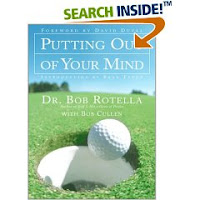Perhaps I mis-titled this post. I guess I should say developing some putting skills instead of improving. Improving implies that I had some skills to begin with. I didn’t. I used to putt like a stoned chihuahua – spazzing out and either timidly leaving it way short or nervously hammering it past the hole with a freakish jolt. In either situation, I would often completely misread the putt in the first place so whether it was short or long it was way off line. Three putts were standard fare and I’d throw in a four or five putt for good measure, especially when I had a “good round” going. I used to dread going to the green to putt and just wanted to get to the next hole so I could take some more swings. My favorite thing about getting a hole-in-one was not having to putt.
Then the one and only Luke Swilor responded to one of my posts lamenting about my putting woes and he recommended the book Putting Out of Your Mind. Dog bless Luke Swilor. And Dog bless Dr. Bob Rotella for writing the book. Now I love putting. I can’t wait to get up there and try to knock it in the hole. That’s my real scoring opportunity!
Book Report – Putting Out of Your Mind, by Dr. Bob Rotella with Bob Cullen

There is really no big mystery to putting. It’s just like it was when you were a kid on a mini-golf course. You look at the target, read the putting surface, choose your line and stroke the ball into the hole. For some reason, now that we’re “adults” and golfers, putting has become so important in our brains that we psych ourselves out about it. At least I did. Suddenly it’s not as simple as it used to be. It means so much more now so it must be more difficult. I must have to concentrate more and really really try. WRONG!
In Putting Out of Your Mind, Dr. Bob Rotella explains it all so simply. It’s not a book that teaches you putting mechanics like holding your triangle or keeping your head over the ball or any of that nonsense. Not that those aren’t things that might work for you, but they might not for someone else. Grips, stances, strokes and routines can vary immensely from golfer to golfer and none is necessarily better than the other. What does have a big impact on every putt no matter who you are is what happens in your head.
This book taught me to develop a solid, repetitive routine. That much is pretty common knowledge, however overlooked or disregarded it can be in any given round. But I also learned not to over-read greens or second guess my lines. Not to stress over speed. “But, but, but… I don’t want to leave it short… I don’t want to end up 10 feet past the hole.” Forget it! If you putt just to get it close, you’re putting to miss. I now putt every putt with the full intention of making it. And guess what? I make a lot more! Sure, I still have the occasional three putt and I’m sure I always will, but I have a lot fewer of them now. More importantly, I make a lot more one-putts.
How can that be? Just by putting to make it? Well, I guess you have to read the book to really have it sink in and be convinced of the overall concept that makes it successful: trust your putt. Just like you have to trust your swing. Speaking of trusting your swing, I have also read and highly recommend Golf is Not a Game of Perfect, also by Dr. Bob Rotella. Every shot I take from under 100 yards, I aim to make it in the hole. I actually chip it in more often now, too.
Of course it isn’t quite as easy as I’m making it out to be. These things take time and I have had some setbacks. But that’s why I decided to refresh my memory of this book by re-reading it and writing this book report.
Dr. Rotella is a psychologist who works with many professional golfers and has done so for years. The book includes many anecdotes from those interactions to illustrate just how important the mental aspect of putting (and golf in general) is. It’s a quick and easy read and can have such a big impact on your game – and your scores.
I highly recommend this book. It’ll make a great holiday gift for your favorite golfer (even if that’s not yourself). Like me, you’ll probably want to pass it along to someone else after you read it. Also like me, you should opt instead to get that person his own copy so you can keep yours on the shelf because you will probably want to read it again. And again.